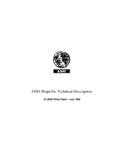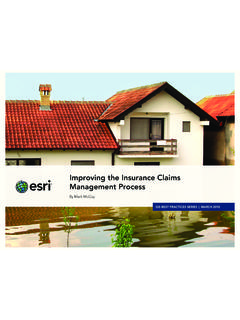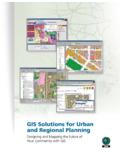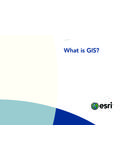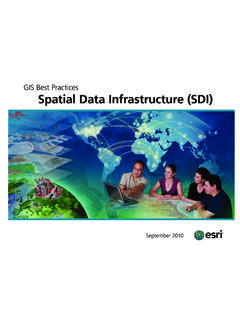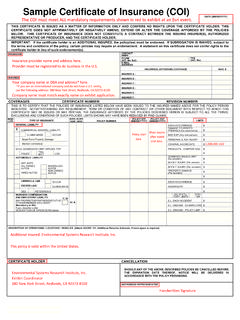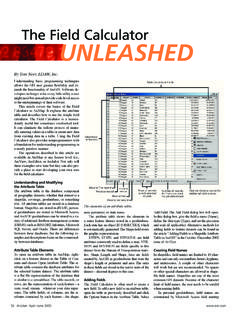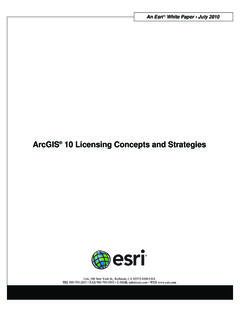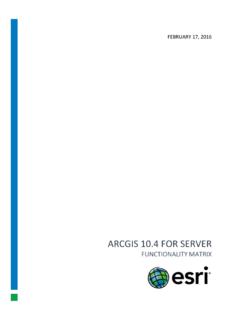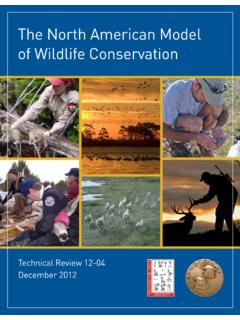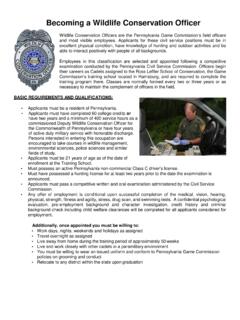Transcription of GIS for Wildlife Conservation - Esri
1 GIS Best Practices GIS for Wildlife Conservation December 2007. Table of Contents What Is GIS? 1. GIS for Wildlife Conservation 3. Launching Spacecraft From a Wildlife Refuge 5. GIS Applications for Gorilla Behavior and Habitat Analyses 15. Philippine Tarsiers Conservation Program Streamlined with GIS 23. The Orangutans of Borneo Are Aided With GIS 29. Turning the Tide for Troubled Albatross 37. Regional Bird Conservation Internet Mapping Tool Takes Flight with GIS 43. i What Is GIS? Making decisions based on geography is basic to human thinking. Where shall we go, what will it be like, and what shall we do when we get there are applied to the simple event of going to the store or to the major event of launching a bathysphere into the ocean's depths.
2 By understanding geography and people's relationship to location, we can make informed decisions about the way we live on our planet. A geographic information system (GIS) is a technological tool for comprehending geography and making intelligent decisions. GIS organizes geographic data so that a person reading a map can select data necessary for a specific project or task. A thematic map has a table of contents that allows the reader to add layers of information to a basemap of real-world locations. For example, a social analyst might use the basemap of Eugene, Oregon, and select datasets from the Census Bureau to add data layers to a map that shows residents' education levels, ages, and employment status.
3 With an ability to combine a variety of datasets in an infinite number of ways, GIS is a useful tool for nearly every field of knowledge from archaeology to zoology. A good GIS program is able to process geographic data from a variety of sources and integrate it into a map project. Many countries have an abundance of geographic data for analysis, and governments often make GIS datasets publicly available. Map file databases often come included with GIS packages; others can be obtained from both commercial vendors and government agencies. Some data is gathered in the field by global positioning units that attach a location coordinate (latitude and longitude) to a feature such as a pump station.
4 GIS maps are interactive. On the computer screen, map users can scan a GIS map in any direction, zoom in or out, and change the nature of the information contained in the map. They can choose whether to see the roads, how many roads to see, and how roads should be depicted. Then they can select what other items they wish to view alongside these roads such as storm drains, gas lines, rare plants, or hospitals. Some GIS programs are designed to perform sophisticated calculations for tracking storms or predicting erosion patterns. GIS applications can be embedded into common activities such as verifying an address. From routinely performing work-related tasks to scientifically exploring the complexities of our world, GIS gives people the geographic advantage to become more productive, more aware, and more responsive citizens of planet Earth.
5 GIS BEST PRACTICES 1 GIS for Wildlife Conservation Habitat loss, global climate change, and human disruptions, such as pollution and deforestation, are threats to Wildlife biodiversity and can cause fragmentation and extinction. GIS technology is an effective tool for managing, analyzing, and visualizing Wildlife data in order to target areas where Conservation practices are needed. Habitat geospatial analysis is an important key to understanding the health of a species in the wild. Monitoring change in Wildlife habitats is feasible with ESRI's suite of ArcGIS software, a tool for managing, analyzing, and depicting statistical and geographic data. GIS helps to monitor and visualize Population and distribution Habitat use and preferences Progress of Conservation activities Historical and present regional biodiversity Understanding threatened species is important in preventing their extinction and revitalizing their populations.
6 ESRI's ArcIMS software makes sharing pertinent Wildlife data on the Web easy and accessible and spreads the Conservation movement across the globe. GIS BEST PRACTICES 3 Launching Spacecraft From a Wildlife Refuge Florida's Cape Canaveral Spaceport GIS. For more than 40 years, the National Aeronautics and Space Administration (NASA) and the Air Force have shared Florida's Cape Canaveral, accomplishing the strange and awe-inspiring achievement of launching spacecraft from a Wildlife refuge. Recently, managing such complexity has become decidedly simpler. Pooling their resources and data, NASA's John F. Kennedy Space Center and the 45th Space Wing's Cape Canaveral Air Force Station implemented a shared GIS.
7 A pair of breeding ospreys nest on a pole in the KSC Press Site parking lot with the NASA logo on the Vehicle Assembly Building in the background. Known collectively as Cape Canaveral Spaceport, the launch pads, research buildings, educational facilities, and administrative offices on and around Cape Canaveral have sprawled to encompass many thousands of acres. Bill Sample, president of Spaceport's operations and maintenance provider, Space Gateway Support (SGS), says, "You essentially have a tremendous block of protected land on which NASA launches the space shuttle and the Air Force launches expendable, nonmanned launch vehicles.". GIS BEST PRACTICES 5 As the Joint Base Operations Support Contract (JBOSC) contractor, SGS is responsible for Spaceport facilities management, public works, engineering services, infrastructure/.
8 Base support services, protective services, logistics, information technology, administrative services, medical services, and environmental services essentially the management of a very specialized, technologically sophisticated city. The SGS contract is unique in Spaceport history, combining NASA and Air Force operations and maintenance into one contract for the first time, improving services, streamlining business practices, and keeping costs down. Implementation of a shared Cape Canaveral Spaceport GIS (CCSGIS) has brought these efforts one step further. "The system represents the partnering of two distinct federal agencies,". says Sample. "It is the blending of their assets to more effectively achieve a common goal, while respecting NASA's scientific mission and the 45th Space Wing's national defense mission.
9 ". Aimed at capturing, recording, displaying, and analyzing geographic information within the Spaceport community, CCSGIS is available only inside existing firewalls. Based on ESRI software's compatibility with other GIS. systems and databases, SGS built CCSGIS. on an ArcView, ArcInfo, ArcSDE, and ArcIMS. foundation. Taken as a whole, the enterprise system supports a framework of Web sites and specialized applications for functions ranging from environmental management to security calls to office allocation. "In 1998," says Sample, "we were challenged to develop a GIS within five years. And that's basically all the information we A map depicting both Kennedy Space Center and Cape had to start the project.
10 Within those years, we Canaveral Air Force Station. The Cape Canaveral were able to build the system from the ground Spaceport GIS is responsible for mapping both installations. up.". DECEMBER 2007 6 GIS FOR Wildlife Conservation . Implementing CCSGIS A project management approach was used to develop the system, relying on a multidisciplinary team of GIS and information technology professionals, real property accountants, and community planners. Using an Oracle database tied to ArcGIS through ArcSDE, SGS created a GIS repository for the whole Cape Canaveral Spaceport, consolidating data from disparate sources and formats. "Most of the data was stored in hard copy and in CAD drawings," says Bill Stoeckel, Real Property Information Systems supervisor, SGS.
